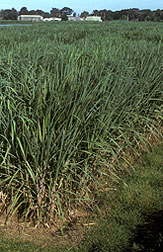This page has been archived and is being provided for reference purposes only. The page is no longer being updated, and therefore, links on the page may be invalid.
|
|
|
|
New Sugarcane Cultivars Developed for Sand Soils of South Florida
By Stephanie YaoDecember 29, 2008
Two new sugarcane cultivars specifically developed for Florida's sand soils have been released by Agricultural Research Service (ARS) scientists and cooperators.
The new cultivars, CP 00-1446 and CP 00-2180, were developed at the ARS Sugarcane Field Station in Canal Point, Fla., as part of an effort to provide growers with more cultivars that yield well on sand soils. The new cultivars are the result of cooperative research with the University of Florida and the Florida Sugar Cane League, Inc.
During testing, potential sugarcane cultivars are evaluated on their yields of cane and sugar. Both CP 00-1446 and CP 00-2180 produced high quantities of cane, and their sugar yields were 32 percent and 15 percent higher, respectively, than the sugar yield of a commercial variety used for comparison.
Growers in Florida usually get three annual harvests from one planting of sugarcane. Both new varieties produce very high cane yields for the first harvest and moderate yields for the other two harvests, commonly referred to as ratoons.
CP 00-2180 is unusual because it is the offspring of a single sugarcane variety, HoCP 91-552. It is rare to have commercially viable offspring from a self-cross of one cultivar.
Florida produces more sugar than any state in the United States. The majority of the sugarcane is produced in organic soils along the southern and southeastern shore of Lake Okeechobee in southern Florida. Twenty percent of Florida's sugarcane acreage is grown on sand soil.
Researchers at Canal Point develop sugarcane cultivars that meet Florida sugarcane growers' needs. The station's goal is to produce disease-resistant varieties that contain good amounts of cane tonnage and sugar content. Research conducted at the station is responsible for substantial yield increases in Florida during the past 40 years.
Seed cane of the releases is available from the Florida Sugar Cane League, Inc., for commercial planting. Small quantities of seed cane for research purposes can be obtained from the ARS Sugarcane Field Station.
ARS is a scientific research agency of the U.S. Department of Agriculture.

